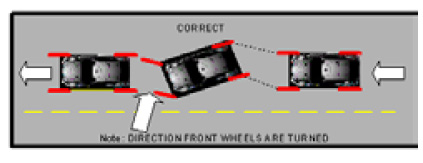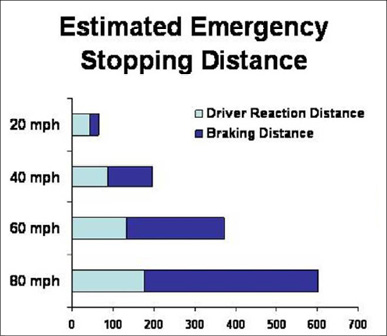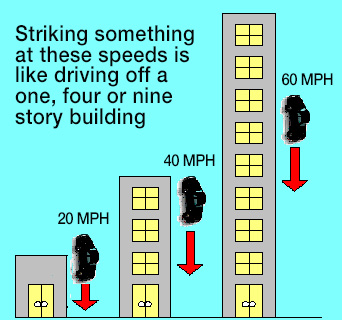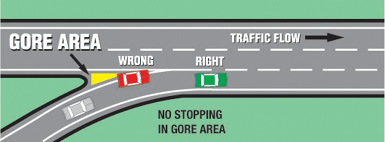General Guidelines
Traffic laws alone cannot regulate every type of driving situation that may occur. There are some general rules which drivers should understand and follow. Read this chapter with care. Someday these safety tips might help you avoid a crash, serious injury, or even death. These are only general statements and cannot dictate your actions in all situations. It is up to you to evaluate the situation and make a determination as to the best course of action.
Entering the Car
- Develop a routine for entering the car safely and preparing for your trip. If you are parked on the street, enter from the curb side of the vehicle. If this is not possible, wait until your entry can be made with reasonable safety and without interfering with the flow of traffic;
- Have your keys ready, and approach the vehicle facing traffic;
- Adjust your seat and mirrors;
- Check passengers to be sure they are properly seated and do not interfere with your view;
- Before starting your ignition, fasten your seat belt and make sure your passengers do the same;
- After starting your vehicle, check around your vehicle for hazards or approaching traffic, including bicyclists and pedestrians, give the proper signal and move cautiously into the stream of traffic.
Steering
Good posture while driving is important because it allows a better view of hazards and more control of the vehicle. As a general rule, when gripping the steering wheel, place your left hand at the 9 o’clock position and your right hand at the 3 o’clock position on the wheel. Some manufacturers recommend placing your hands at 8 o’clock and 4 o’clock positions when the vehicle is equipped with air bags. Check your owner’s manual or contact your vehicle manufacturer to determine which position is best for your vehicle. Always keep both hands on the wheel unless you are safely performing another driving-related task, such as activating your turn signal.
Fog
If possible, avoid driving in heavy fog. If you must drive, follow these guidelines:
- Reduce driving speed;
- Reduce speed further when you see headlights or red tail lights. These indicate the presence of another vehicle and, due to fog, it may be more difficult to accurately judge the distance between your vehicle and others;
- Dim your headlights. Bright lights produce a glare in heavy fog, actually making it more difficult to see than when using regular headlights;
- Do not drive with parking or hazard lights on.
Hydroplaning
Hydroplaning occurs when there is standing water on a roadway. At speeds up to 35 mph, most tires will channel water away from the tire similar to the way a windshield wiper cleans the windshield. As your speed increases, tires cannot channel the water as well, and your tires may start to lose contact with the road and ride over the water like a set of water skis. In a standard passenger car, partial hydroplaning can begin at speeds as low as 35 mph. At 55 mph, the tires may lose all contact with the road. If this occurs, there is no friction available to brake, accelerate, or steer. It is possible for the vehicle to go into an unpredictable and uncontrollable skid. If this occurs, take your foot off of the accelerator, letting the car slow down. To prevent hydroplaning, maintain good tires with adequate water-channeling thread on your vehicle. Most importantly, slow down when there is water on the roadway.
Skidding
A car skids when its tires lose their grip on the road surface. When a car skids, both the power that the engine sends to the wheels and the braking ability of the wheels are lost. Slick surfaces can exaggerate normal movements. If brakes are applied too hard, or the wheel is turned too sharp, a skid can occur.
If you start to skid:
- ease your foot off of the accelerator;
- begin turning the steering wheel in the direction of the skid;
- once you have regained control of the vehicle, you can lightly apply brakes and steer in a safe direction.

Remember, the first half-hour of rainfall is the most dangerous because roadways become extremely slippery when the water mixes with oil and other chemicals on the road surfaces.
Curves
Curves in a roadway are potential sources of hazard for drivers. Because of the maneuvering involved, it is more likely that a less cautious driver may fail to maintain their lane while driving through a curve. When roadways are slick because of rain or other hazards, curves can be especially dangerous and require much lower speeds than when the road is dry. Sharper curves are usually marked with a safe miles-per-hour sign. Usually less than the posted speed limit, these advisory signs indicate that the reduced speed shown will make driving through a curve safer.
Reduce your speed before entering these curves. If, while driving through the curve, you realize that you are traveling too fast, do not forcefully apply brakes because this may cause your vehicle to skid. Instead, take your foot off the accelerator, carefully apply the brake, and continue steering in the lane of travel.
Leaving the Roadway
Uneven terrain and obstacles make it difficult to safely maneuver a vehicle once it has left the roadway. Serious injury or death can result from a crash if this happens.
To avoid leaving the roadway while driving, pay attention to road conditions. Drive at or below the speed indicated on a regulatory sign or an advisory sign indicating potential hazards. Drive defensively, being mindful of the actions of drivers around you.
If your vehicle leaves the roadway, try to follow these guidelines:
- Don’t panic;
- Take your foot off the accelerator;
- Grip the steering wheel tightly and be prepared to withstand sudden shocks;
- Don’t hit the brake pedal suddenly and hard; use your brakes carefully;
- Don’t try to turn back onto the pavement immediately. Overcompensating (“jerking the wheel”) when returning to the roadway can cause you to lose control of your vehicle by skidding or flipping, or may also cause your car to go into other lanes of traffic;
- Wait until your speed has reduced, check the traffic, and look for a place to safely return to the roadway by merging into traffic. If necessary, come to a complete stop before re-entering the roadway.
Tire Blow-Out
Unlike a slow leak which may cause a tire to go flat over time, a blow-out occurs when the tire ruptures and goes flat immediately. If this occurs while your vehicle is in motion, it can cause you to lose control.
If you experience a sudden tire blow-out, do not panic. Follow these guidelines to maintain control of the vehicle.
- Apply brakes lightly if necessary and safe to do so;
- Grasp the steering wheel firmly and take your foot off the accelerator to allow the vehicle to roll to a stop;
- Do not move to the shoulder of the road until the car has slowed greatly. If the blow-out causes the car to swerve on to the shoulder, do not try to get back on the pavement. Let the car coast to a stop. See the guidelines above for what to do when your vehicle leaves the roadway.
Winter Driving
Winter weather can create many driving hazards. Because of the usually mild climate, most Georgians are not experienced in driving in winter weather. Here are several suggestions to help you drive safely in winter weather:
- Use chains or snow tires if road conditions require extra traction. Always check the manufacturer’s instruction manual for your vehicle, the tires, and the chains before installing them on your vehicle and operating on a roadway;
- Keep windows clear. Remove snow and ice from all window surfaces before operating the vehicle on a roadway;
- When you first enter the roadway, and if it is safe to do so, get a “feel” for the road. Test your brakes gently. Determine how your vehicle will respond to turning the wheel by making slight adjustments. Never apply sudden braking. Instead, slow down gradually before you come to an intersection, make a turn, or stop;
- Keep a safe distance between you and other vehicles;
- Reduce speed according to conditions;
- Watch for hazards or changing road conditions ahead.
Tips for Safe Winter Driving
- Get your car serviced routinely.
- Check your battery.
- Check your cooling system.
- Fill your windshield washer reservoir.
- Check your windshield wipers and defrosters.
- Verify floor mat installation to prevent pedal interference.
- Inspect your tires.
- Check the age of your tires.
- Know your car.
- Plan your travel and route.
- Stock your vehicle with necessary tools and supplies.
- Learn what to do in a winter emergency.
Carbon Monoxide
Cars produce carbon monoxide, a deadly odorless and colorless gas. Symptoms of carbon monoxide poisoning are sudden weariness, yawning, dizziness, and nausea. Simple precautions to avoid carbon monoxide are:
- Don’t leave the car motor running in a garage;
- Don’t leave the car motor running and the windows closed while the car is parked;
- Don’t operate the heater or air conditioner in a parked car with the windows closed;
- Don’t drive with a defective muffler or exhaust system.
Move a victim of carbon monoxide poisoning to fresh air, contact emergency medical services, and give artificial respiration if it is necessary and you are trained to do so.
Steering Locks
Steering locks are anti-theft devices found in most cars manufactured since 1969.
Steering locks can cause dangerous situations for drivers who are not familiar with their operation. If a vehicle’s ignition is placed in the lock position while the vehicle is in motion, the steering capability of the vehicle will be disabled, and the driver will be unable to steer the vehicle.
Further information concerning steering locks is available from the Automobile Safety Foundation at www.carsafe.org.
Following Too Closely
A rear-end crash is caused by following another vehicle too closely. When following another vehicle on any street or highway, there must be enough distance for you to safely stop if the vehicle in front of you suddenly slows down or stops. One way to determine if there is enough distance between your vehicle and the vehicle in front of you is to measure the amount of time between when the vehicle in front of you passes a reference point and when your vehicle passes the same reference point. Watch the car ahead of you. When it passes a reference point, such as a telephone pole or street sign, count “one-thousand-one, one-thousand-two.” If you pass the same spot before you are through counting, you are following too closely. During inclement weather, during construction, during heavy traffic, and always at night, the distance between your vehicle and the vehicle in front of you should be even greater.
Speed and Stopping Distance
The distance it takes to stop your vehicle is important in determining a safe driving speed. The chart below may be used as a guide, but actual stopping distance can depend on the following factors in addition to vehicle speed:

- Mental and physical reaction of the driver;
- Type and condition of the pavement;
- Kind of tires and tread composition;
- Chassis (frame) design;
- Type of brakes, condition, and balance of brakes;
- Wind direction and velocity.
Speed is a leading factor in serious injury and death as a result of traffic crashes. The greater the speed, the greater the force of impact. The illustration below conveys the relative force of impact when you strike a fixed object.

Expressway Driving
An expressway differs from normal roads or highways in that access to it is controlled. Vehicles can only enter and exit the expressway at specific places known as interchanges. Most expressways in Georgia are free, but there are a few that require a toll.
With the exception of the controlled enter/exit points and HOV lanes, expressways are similar to traveling on a divided highway. There is a median separating traffic traveling in opposite directions; lanes are marked with dashed lines, and the edge of the roadway is marked with a solid line; slower traffic should keep to the right; and all traffic laws and guidelines associated with safe driving still apply.
Entering Expressways
The entrance ramp is a short one-way road that leads to the expressway. From the entrance ramp, you should move into the acceleration lane. This is the lane that runs alongside the main roadway. In the acceleration lane, you can adjust your speed to the speed of the expressway traffic. When safe to do so, you should merge into traffic. Vehicles on the expressway have the right of way, but courteous drivers will permit you to move into the expressway traffic.
Exiting Expressways
Prepare to exit a controlled access highway by safely moving to the right lane for an exit on the right, or the left lane for an exit on the left. Guide signs will tell you of the approaching exit. At the exit, deceleration lanes are provided for slowing down when leaving the expressway. Posted exit speeds are usually low due to the design of the roadway. Drivers should use either brake lights or a turn signal to indicate a change in speed to the drivers behind if slowing down in the traveling lane when preparing to exit.
Use of Lanes on Expressways
Drivers operating vehicles on divided highways must drive to the right of the median unless directed to do otherwise by a sign, traffic control device, or police officer. Drivers must obey the yellow or white striping on the roadway that indicates lanes, the convergence of lanes, or areas in which vehicles should not operate. Drivers may only access or exit controlled-access roadways at designated entrances and exits.
Gores
The term “gore” means the area of convergence between two lanes of traffic. The gore is the area, usually similar to a triangle, formed by solid white lines between an existing lane of travel and a merging lane of travel. Gores are most often seen at the convergence of an acceleration lane and the adjacent travel lane on a controlled access highway. The gore is the area bounded by solid white lines between the acceleration lane and the adjacent travel lane. Drivers entering the controlled access highway are prohibited by law from crossing this solid white line, and are required to continue traveling in the acceleration lane until the solid white line disappears.

HOV Lanes
High Occupancy Vehicle (HOV) lanes are travel lanes that are restricted to vehicles with more than one occupant, buses, motorcycles, and vehicles with Alternative Fuel Vehicle license plates. The lanes are marked with a diamond symbol and the hours of restriction are posted. The penalty for violating HOV lane restrictions is a fine up to $75 for a first offense; up to $100 for a second offense; up to $150 for a third offense; and up to $150 plus one point added to the violator’s driving record for a fourth or subsequent offense.

HOV Lanes
Double White Lines (No Entry)
Dashed White Line (You May Enter)
Hot Lanes
High Occupancy Toll (HOT) lanes are I-85 Express Lanes that allow registered transit, three or more person carpool, motorcycles, emergency vehicles, and Alternative Fuel Vehicles to use the lanes toll-free.
Tips For Expressway Driving
- Plan your trip carefully. Mark the map to indicate all entrances, service areas, and exits you plan to use. Doing these things will help you to have a safe, fast, and pleasant journey. You can check the website www.511ga.org for road construction, road closures, exit numbers, and other information to help plan your trip;
- Check your car before you start. Because expressways are designed for faster and smoother flowing traffic, there are fewer places to exit. It is important to check your gasoline gauge and make sure you have enough fuel. Also check the water, oil, and tires of your vehicle;
- Be alert. Use your rear view mirror and side mirror to constantly check the traffic around you. Always make visual traffic checks before you change lanes;
- Stay out of another driver’s blind spot. Traveling in a position where the driver ahead of you cannot observe your vehicle in the rear view or side mirrors is a dangerous practice; the driver might pull out in front of you to pass a car. Either stay far enough behind so that the other driver can see you, or pass the vehicle. This is especially true for driving near large vehicles. Tractor-trailer combinations, also known as “eighteen-wheelers”, are limited in their visibility because of their size;
- Use turn signals. Be sure to activate your right or left turn signal to indicate that you are changing lanes BEFORE you begin the maneuver;
- Allow plenty of room when passing. Returning to your lane of travel before you have passed another vehicle and provided enough safe distance between the two can cause a crash. Carefully check the left lane behind you before pulling out to pass. Don’t pull back into the right-hand lane until you can see the car that you just passed clearly in your rear view mirror;
- Always obey the posted maximum and minimum speed limits. These laws exist to regulate the flow of traffic and to create a safe environment for all drivers;
- In metro areas, expressways will usually have a dramatically increased amount of traffic during the hours that most drivers are traveling to and from their places of employment. The number of cars on the expressway during this time will lead to delays. During this time, drivers should be particularly cautious. Driving defensively, allowing a safe distance between vehicles, and obeying all traffic control signs and devices can help ensure a safe commute;
- Don’t back up. Driving in reverse on an expressway is prohibited under any circumstances;
- Stopping on the expressway is prohibited. You will find rest areas and service signs at frequent intervals; use them. Stopping on the roadway shoulder is highly dangerous and permitted only in an emergency. Switching drivers, stretching, or retrieving an item from the back of the vehicle is NOT considered an emergency. If it is necessary to stop, raise the hood and activate your hazard lights to indicate difficulty. Don’t walk along the expressway in search of help;
- Drowsiness and fatigue is a danger anytime you drive, but is especially dangerous on long trips along the expressway. Stop driving if you feel drowsy. Don’t rely on stimulant drugs (also called Stay Awake Drugs). They are likely to make your driving even more hazardous. Expressway drivers are subject to “highway hypnosis,” a condition of drowsiness or unawareness brought on by monotony, the sound of the wind, the tires on the pavement, and the steady hum of the engine. On long trips it is a good idea to “exercise your eyes” to help keep you alert. Keep shifting your eyes from one area of the roadway to another and focus on various objects, both near and far, left and right. Conversation with other passengers and lively radio programs may also help you remain more alert. Of course, always pay attention to the traffic around you and potentially hazardous highway conditions;
- Drive defensively. The key to defensive driving is awareness. You must keep your eyes moving so that you can keep track of what is happening around you at all times. Avoid staring at the center line on the roadway. Instead, look ahead for trouble spots which may endanger you or your passengers. A defensive driver will also frequently check the rear view and side mirrors to keep abreast of the traffic and road conditions to the rear and sides;
- Never trust other drivers to do what you think they are going to do or what you think they should do in a particular situation. The fact that a left turn signal is flashing does not necessarily mean that the driver is going to make a left turn. You should constantly be thinking of an “escape route” as you drive. For example, if you are approaching a curve, you should be looking closely at the shoulder and nearby area to determine what you would do if a car approaching from the other direction crosses to your side of the road. After a little practice this will become more instinctive.
Protecting the Air
The operation of motor vehicles has a significant impact on Georgia’s air quality. Emissions from cars and light duty trucks contribute to the formation of ground-level ozone, a component of urban smog. Vehicle emissions can react with sunlight at high temperatures to produce unhealthy levels of this form of air pollution. This is especially true during warm weather. Vehicle emissions and ground-level ozone can be reduced by proper vehicle maintenance in accordance with the manufacturer’s instructions, and by fewer trips and vehicle miles traveled.
In the thirteen-county metro Atlanta area, gasoline-powered cars and light-duty trucks that are less than 25 model years old must pass an emissions inspection every year prior to registering their vehicle with the county of residence (the most recent three model years are exempt from this requirement). The thirteen metro counties covered by the state’s inspection and maintenance program are: Cherokee, Clayton, Cobb, Coweta, DeKalb, Douglas, Fayette, Forsyth, Fulton, Gwinnett, Henry, Paulding and Rockdale. For more detailed information about the emissions inspection program, call the Georgia Clean Air Force at 1-800-449-2471. Remember removing or disabling a vehicle’s emissions control components is a violation of federal and state law.
In addition to proper vehicle maintenance, you can help reduce air pollution and traffic congestion by limiting driving to necessary travel, by planning ahead to consolidate trips, and by using carpools, transit and ridesharing. All drivers should do their part to reduce the impact of automobiles and trucks on air quality and the environment.
Idling Engines
Minimize your idling time. Eliminating unnecessary idling can reduce fuel consumption, engine wear and air pollution. When warming up the engine, follow the manufacturer’s guidelines to assure sufficient engine performance for safe driving. Idling a vehicle for 10 seconds will consume more fuel than restarting the engine.
